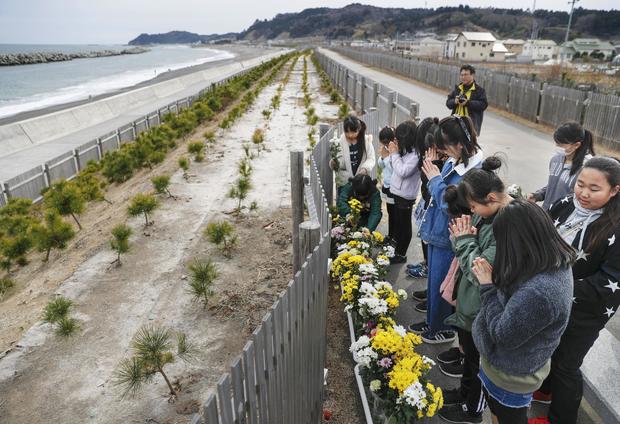【声明】フクシマ事故と東京オリンピック―小出裕章
原発事故を忘れさせる目的は許されない
昨年8月、小出裕章さん(元京都大学原子炉実験所助教)が、「フクシマ事故と東京オリンピック」を発表した。イタリア在住の知人・楠本淳子さんが声明を依頼し、英訳文を世界各国のオリンピック委員会に送る。原子力村の罪深さを余すところなく究明し、「東京五輪返上論の具体的・理論的な決定版」(村田光平・元駐スイス大使)との評価もある。同声明の要約を紹介し、声明を発表した小出さんに、込めた思いを綴っていただいた。 (文責・編集部)
事故原発の現状
福島原発事故で、原子炉が熔け落ち、広島原爆の168倍もの放射能が大気中にばらまかれ、海に放出されたものも合わせると、広島原爆約1000発分程度の放射能が環境に放出されました。炉心が熔け落ちた原子炉は、1・2・3号機合計で広島原爆約8000発分のセシウム137が炉心に存在していました。放射性物質の大半は、いまだに原子炉建屋などに存在しています。
これら放射性物質を環境に放出しないように、炉心に水を注入し続けていますが、汚染水の総量は100万トンを超え、原発敷地内のタンクは、1000基を超えています。近い将来、東京電力は放射能汚染水を海に流さざるを得なくなるでしょう。
終わりなき廃炉作業
一番大切なのは、熔け落ちた炉心を安全な状態に持っていくことですが、今も、炉心がどこに、どんな状態であるかすらわからないのです。国と東京電力はロボットを行かせようとしてきましたが、被曝に弱く、ほぼすべてが帰還できませんでした。
私は、チェルノブイリ原発事故の時にやったように石棺で封じるしかないと言ってきましたが、石棺の寿命はせいぜい100年程度です。封じ込めた放射能を、数十万年から100万年、安全に保管し続けなければならないのです。
棄民政策と 復興政策
発電所周辺でも、極度の悲劇が進行中です。事故当日、原子力緊急事態宣言が発令され、強制避難の指示が拡大しました。突然、家族、仲間、隣人、恋人たちとの穏やかな日が断ち切られ、避難所、仮設住宅、災害復興住宅や、みなし仮設住宅へ移らざるを得ませんでした。生活を丸ごと破壊され、絶望の底で自ら命を絶つ人も、いまだに後を絶ちません。
強制避難地域の外側にも、本来「放射線管理区域」にしなければいけない汚染地帯が広大に生じています。区域内は本来、飲食も寝ることも禁止です。ところが国は、緊急事態だとして、その汚染地帯に数百万人の人を棄てたのです。
被曝を避けるために、仕事を捨て、家族全員で避難した人もいます。子どもと母親だけ避難した人もいますが、家庭崩壊が深刻です。汚染地に残れば身体が傷つき、避難すれば心が潰れるのです。
その上、国は、年間に20ミリSvを越えない汚染地であれば帰還するよう指示し、住宅補償を打ち切りました。
福島では復興が何より大切だとされています。人は毎日、恐怖を抱えながらは生きられません。汚染を忘れてしまいたいし、国や自治体は積極的に忘れてしまえと仕向けてきます。逆に、汚染や不安を口にすれば、復興の邪魔だと非難されてしまうのです。
1年間に20ミリSvという被曝量は、「放射線業務従事者」に対して初めて許した被曝の限度です。それを被曝からは何の利益も受けない人々に許してはいけません。とりわけ、フクシマ事故に何の責任もない赤ん坊や子どもにまで、放射線業務従事者の基準を当てはめるなど、決してしてはならないことです。
子どもたちを被曝から守ることが、大人の最低限の責任です。国を筆頭とする加害者集団「原子力マフィア」の誰一人として責任を取らないまま、逃げおおせようとすることを許してはなりません。
国威発揚の場と しての五輪
事故後7年半たっても「原子力緊急事態宣言」は解除されていません。「原子力緊急事態宣言」が今なお解除できず、本来の法令が反故にされたままであることを多くの国民は忘れさせられてしまっています。
今大切なのは、「原子力緊急事態宣言」を一刻も早く解除できるよう働くことであり、事故で苦しみ続けている人たちの救済こそ、最優先の課題です。
にも拘わらず、この国はオリンピックが大切だといっています。いつの時代、どこの世界もそうでしたが、内部に深刻な問題を抱える時に権力が使うのはお祭り騒ぎでした。オリンピックもそのように利用されてきましたし、特にフクシマ事故が続いている今、安倍政権にとっては東京オリンピックはそれ以上ない宣伝になっています。フクシマを忘れさせるため、マスコミは今後ますますオリンピック熱を流し、オリンピックに反対する輩は非国民だと言われる時が来るでしょう。
罪のない人を棄民したままオリンピックが大切だという国なら、私は喜んで非国民になろうと思います。
原子力緊急事態宣言下の国で開かれる東京オリンピック。それに参加する国や人々は、一方では被曝の危険を負いますが、一方では、加害者である国が、被害者を棄民したまま、フクシマ事故をなかったものとするという国家犯罪に加担する役割を果たすことになります。
















